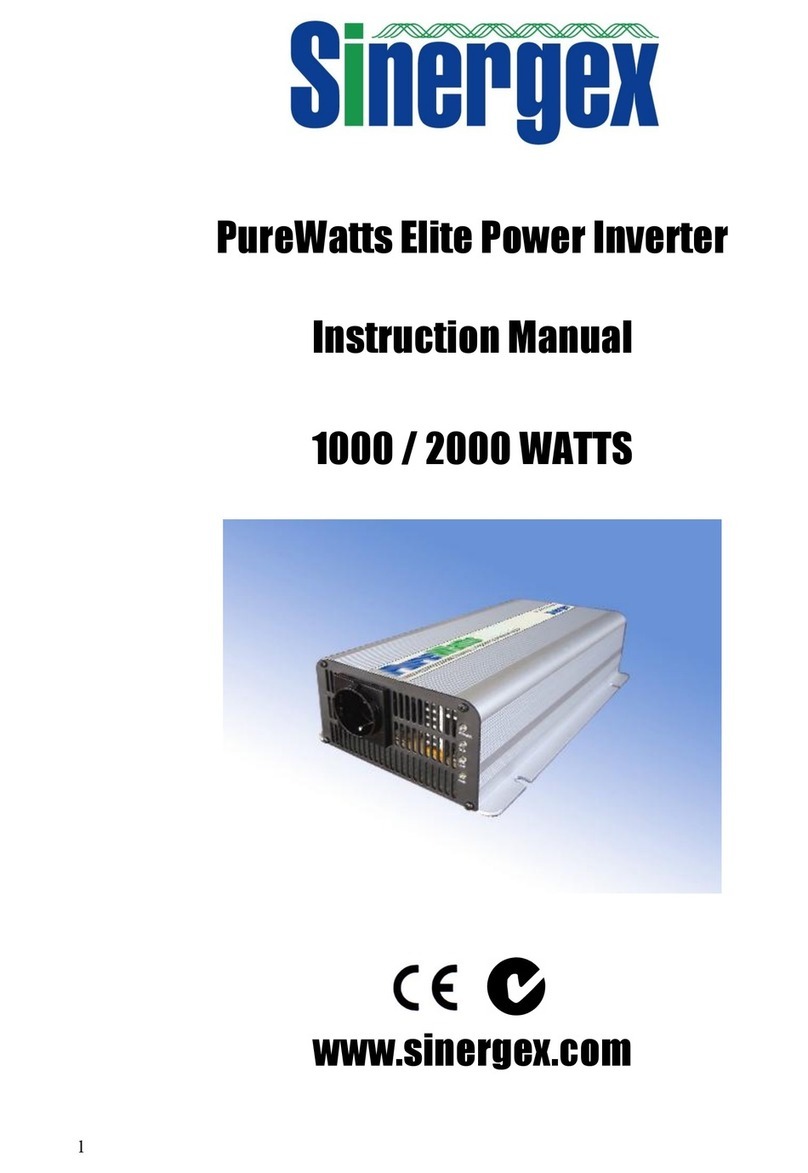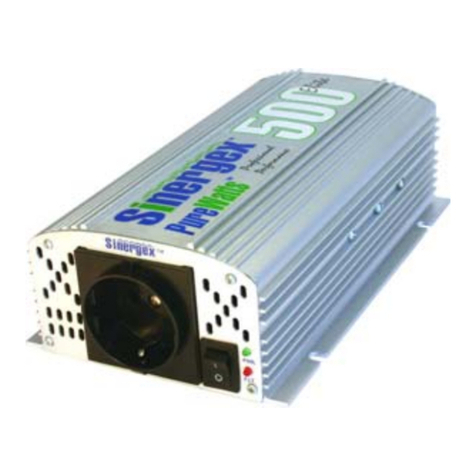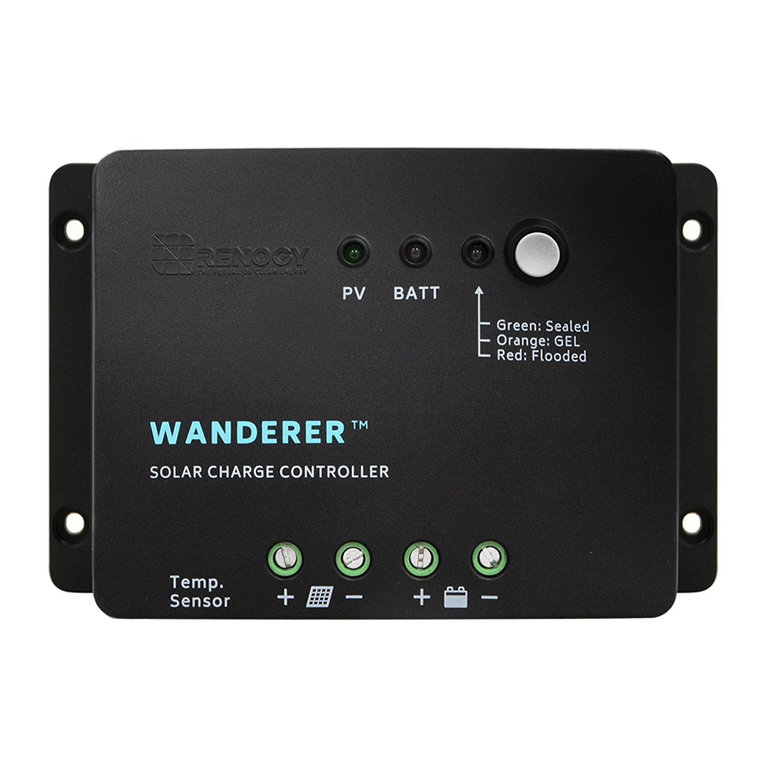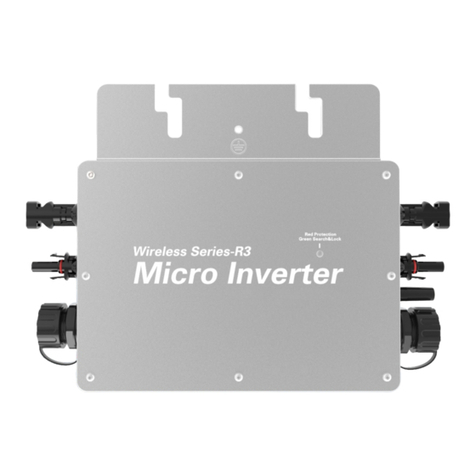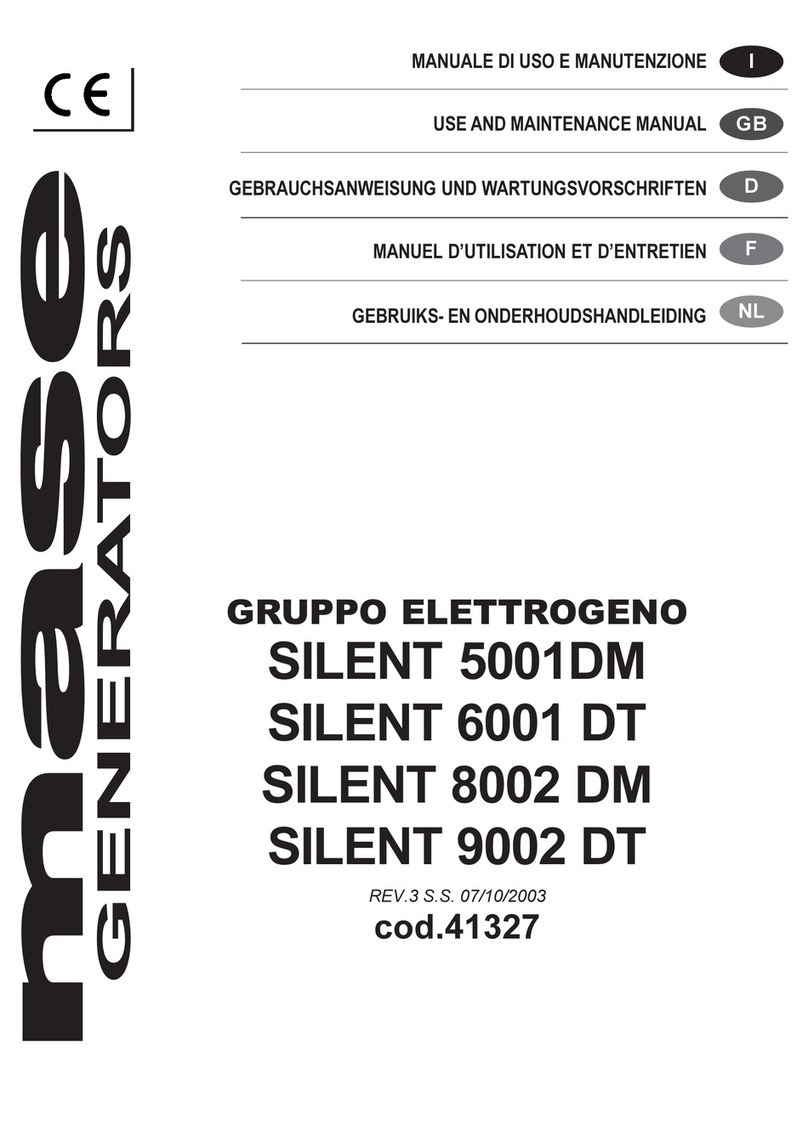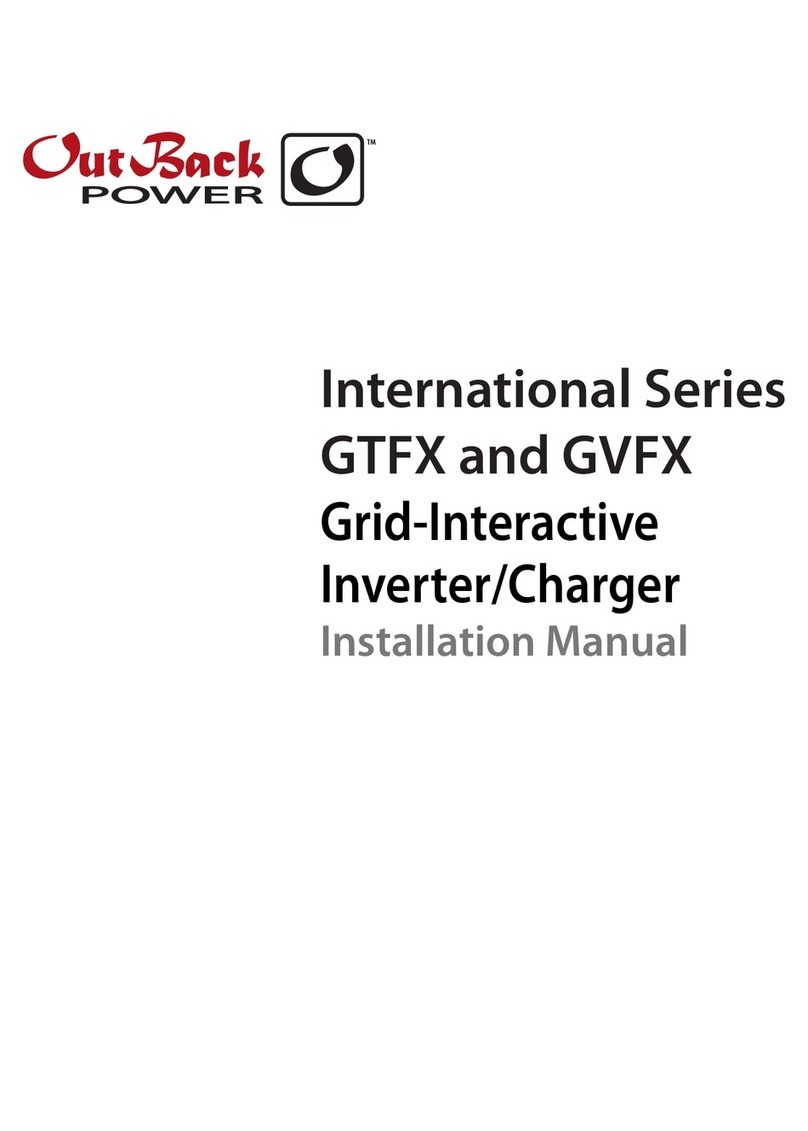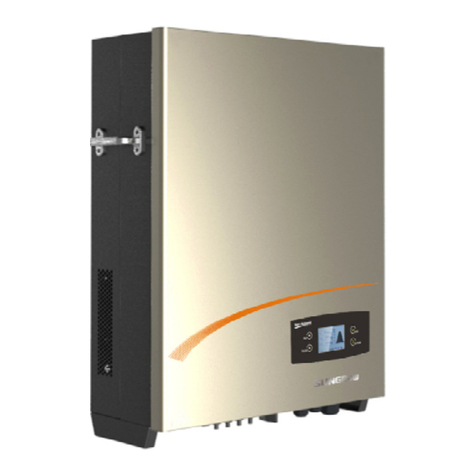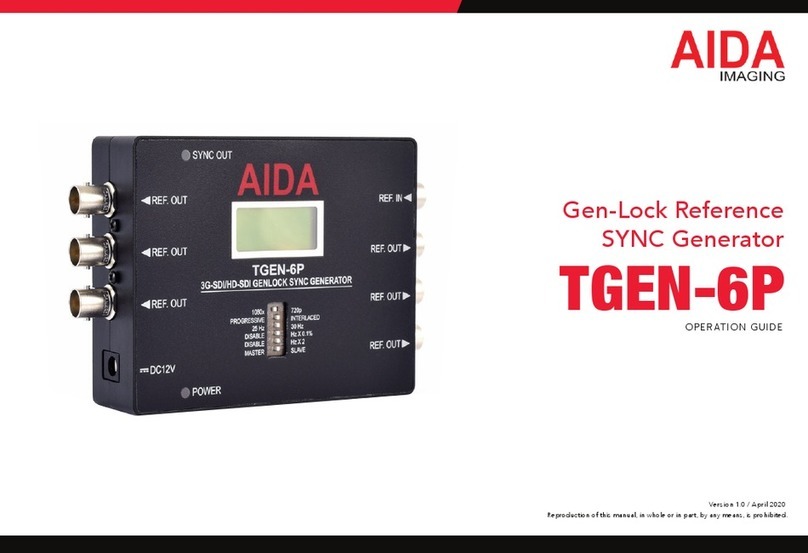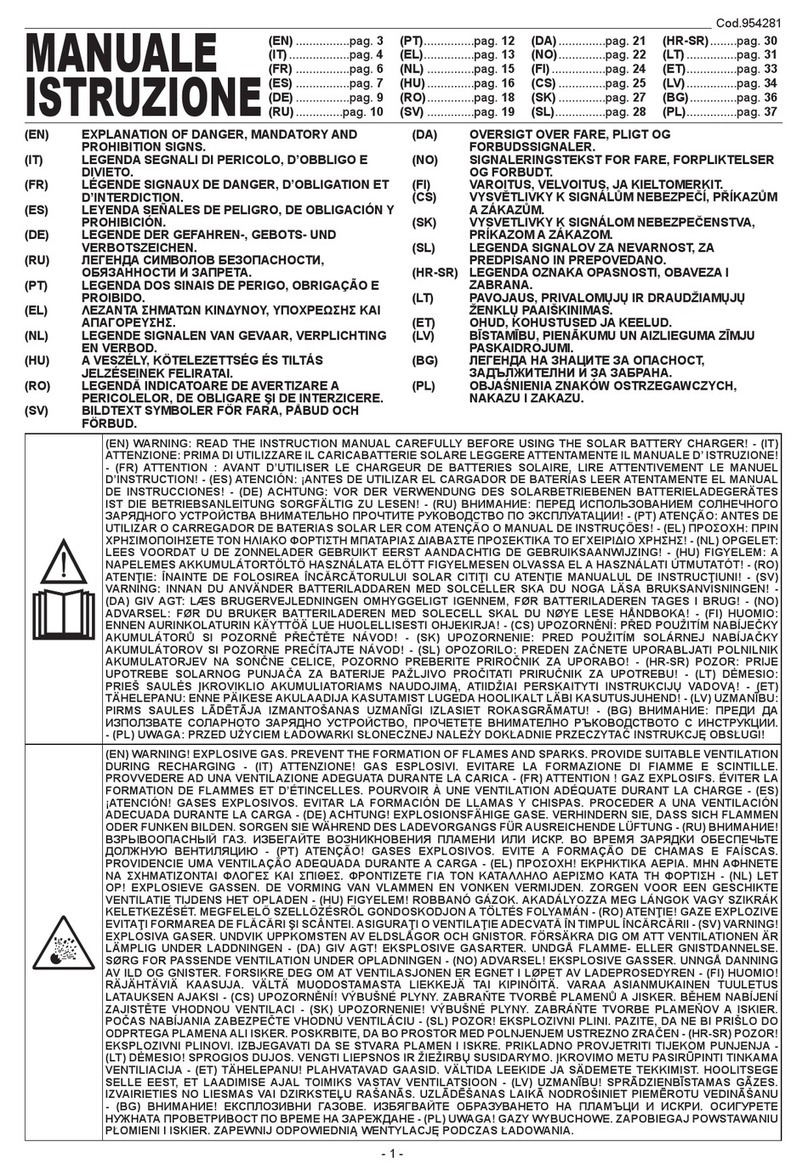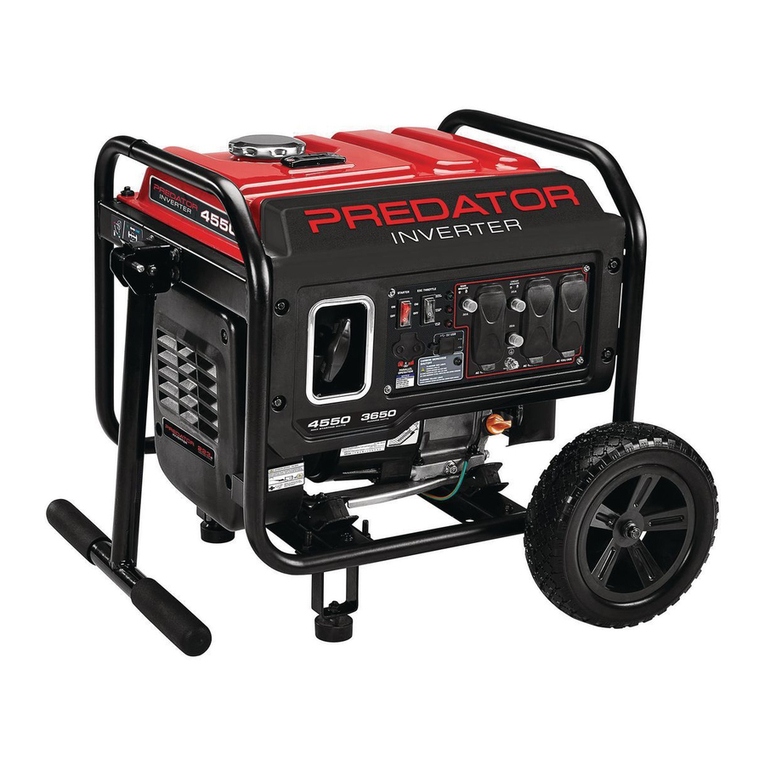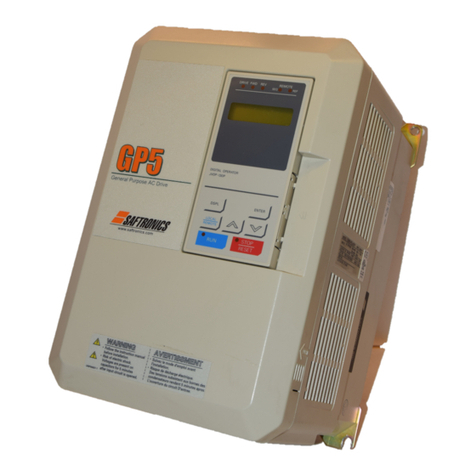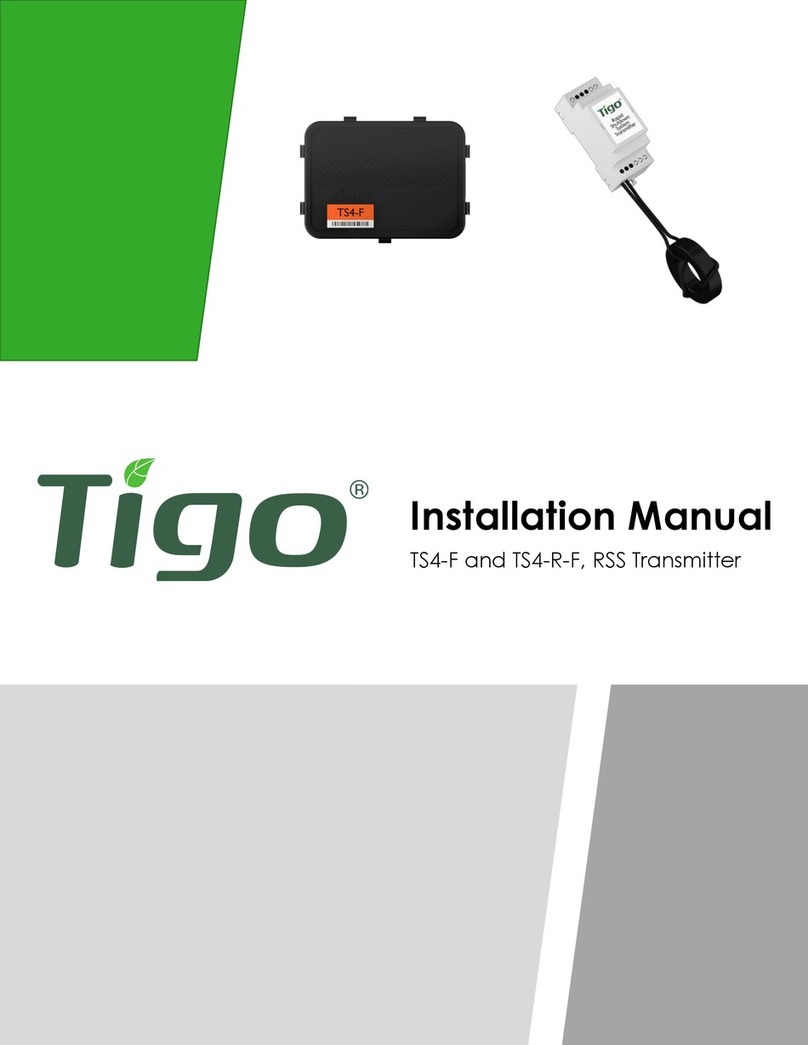Sinergex PureWatts 1000 User manual

DC to AC POWER INVERTER
PureWatts 1000/1500
OWNER'S MANUAL
SinergexTM
Technologies

D. Battery Condition Display B. Over Temperature Warning Light
A. ON/OFF Power Switch
C. Overload Warning Light
E. AC Outlets
A. ON / OFF Power Switch:
Ensure the switch is in the OFF position during installation.
B. Over Heating Warning Light
The over heating warning light will turn on when the inverter protects itself against over-
heating. The inverter will automatically shut down when the warning light is on. The
will restart automatically and warning light will turn off when the inverter cools.
2
125
100
75
50
25
15
14
13
12
11
10
BATTERYBATTERY
OVER
OVER
LOAD
TEMP
AMPS VOLTS
ONON
OFFOFF
INTELLIGENT CONTROL SYSTEMINTELLIGENT CONTROL SYSTEM
OUTPUT:
110VAC
60Hz.
1000W
CONT.
A. Ventilation Window:
Do not obstruct. Must allow a minimum of 1 inch space for air flow.
Once inverter has cooled continue normal operation.
C. Overload Warning Light.
The overload warning light will turn on and the inverter will shut down when
overloading occurs. To reset the inverter, turn the power ON/OFF switch to
the OFF position and decrease the power load. Once load is decreased turn
the inverter power ON/OFF switch to the ON position and proceed normal
operation.
D. Battery Condition Display.
The battery condition display gives information on the voltage and current of
your battery. For optimum performance the current should be in the green zone
of the display for continuous operation. The inverter will operate for several
minutes in the yellow zone. Operation in the red zone of voltage or current will
result in the inverter's protective shut down.
E. AC Outlets.
Outlet Sockets Available: North America
Europe (Schuko)
United Kingdom
Australia/New Zealand
2. Rear Panel
3
Sinergex PureWatts 1000
PW-1000-12
Thank you for purchasing a Sinergex power inverter. The PureWatts power inverter series
are members of the most advanced line of mobile AC power systems available.
The PureWatts 1000 and 1500 are used in a wide range of applications, including remote
homes, recreational vehicles, boats, heavy trucking, and mobile utility vehicles. The
PureWatts 1000 and 1500 will operate most televisions, video cassette recorders, power
tools, personal computers, analog microwave ovens, drills, sanders grinders, mixers and
blenders and many other types of equipment that require AC power.
To get maximum performance from you inverter, it must be installed correctly. Please take
the time to read the instructions in this owner's manual before installing and operation.
1. Front Panel.
A. Ventilation Window
B. DC Battery Terminals C. Chassis Grounding
Introduction

4
5
B. DC Battery Terminals:
Connect the inverters to a 12 or 24 volt battery or another 12 or 24 volt power source.
Red is positive (+) and Black is Negative (-). WARNING: Ensure that when
connecting DC source to inverter, that the negative cable runs to negative terminal and
the positive cable runs to positive terminal. Reversing these will blow an internal fuse
and may cause permanent damage to the inverter. REVERSE POLARITY WILL VOID
WARRANTY!
C. Chassis Grounding Lug:
Connect the chassis grounding lug to earth ground or to vehicle chassis using # 8
AWG wire.
WARNING: Operation of the inverter without proper ground connection may
result in an electrical safety hazard.
QUICK INSTALLATION AND TESTING
If you would like to test the inverter and check its performance before final installation,
please follow these guidelines:
1. Unpack and inspect the inverter. Ensure the power ON/OFF switch is in the OFF
position.
2. Connect the DC cables to the DC battery terminals on the rear panel of the
inverter. The red terminal is positive (+) and the black terminal is negative (-).
Connect the cables into the correct terminals and tighten the terminal securely.
3. Connect the DC cables for the negative (-) terminal of the inverter to the negative (-)
terminal of the battery. Ensure a secure connection is made.
CAUTION! The failure to make a secure connection between the battery and the inverter
terminals will result in excessive voltage drop and may cause overheating of the cables
and the insulation to melt.
4. Before proceeding with test, carefully check to ensure that the cables are connected
to the correct terminals. That is negative (-) to negative (-) and positive (+) to
positive (+).
CAUTION! Reverse polarity connection will blow and internal fuse and may cause
permanent damage to the inverter. DAMAGE CAUSED BY REVERSE POLARITY
CONNECTION IS NOT COVERED UNDER WARRANTY.
5. Connect the cable from the positive terminal of the inverter to the positive
terminal of the battery. Ensure a secure connection is made.
WARNING! You may observe a spark when you make this connection
due to current flow to the inverter to charge capacitors within the inverter.
Do not make make this connection in the presence of flammable fumes
or liquids or an explosion or fire may result.
6. Set the Power ON/OFF Switch to the ON position. Check the Battery Condition
Display. The voltage display should indicate 11 to 14 Volts for the PW-1000-12
and PW-1500-12 and 22 to 28 Volts for the PW-1000-24 and PW-1500-24,
depending on the battery or other power source.
7. Set the inverter Power ON/OFF Switch to the OFF Position. The lights on the
display may blink and an internal alarm may sound momentarily. This is normal.
Plug the test load into the AC receptacle on the front panel of the inverter.
Leave the Power ON/OFF Switch in the OFF position.
8. Set the Power ON/OFF Switch to the ON position and turn the test load on.
The inverter should supply AC power to the test load. If you desire to measure
the true output R.M.S. voltage of the inverter a FLUKE 87 BACKMAN 4410
or TRIPLETT 4200 must be used.
WARNING! THE TESTING PROCEDURE ABOVE IS FOR TEST
PURPOSES ONLY AND NOT FOR PERMANENT INSTALLATION.
PERMANENT INSTALLATION
1. Where to Install:
The inverter must be installed in a location that meets the following requirements:
A. A dry location. Do not allow water or other liquids to drip or splash on the
inverter. Water damage will void warranty.
B. A Cool location. Ambient air temperature should be between 0 degrees Celsius
(32 degrees Fahrenheit) and 40 degrees Celsius (110 degrees Fahrenheit). The
cooler the location, the better performance will be achieved.

C. Ventilated Location: Allow as least one (1) inch of clearance around the inverter
to allow good air flow. Ensure the ventilation windows on the rear and bottom of
inverter are not obstructed. Efficient air flow will help the inverter achieve
optimum performance.
D. Safe Location: Do not install the inverter in the same compartment as the batteries
or in any compartment where flammable liquids or fumes may be or may become
present.
2. CABLES
DC to AC power inverters require high amperage and low voltage DC power to
low voltage/high amperage voltage AC power. To get maximum performance,
connect the inverter directly to the battery with the heaviest cable available.
To achieve greater efficiency, keep the length of the cable between the inverter
and the battery to a minimum. Please refer to chart below cable size.
Max.Watts Out Approx. Amps Req'd Wire Gauge
100 Watts 10 Amps #18
150 Watts 15 Amps #14
200 Watts 20 Amps #12
300 Watts 30 Amps #10
400 Watts 40 Amps #8
600 Watts 60 Amps #6 or 2 x #10
800 Watts 80 Amps #4 or 2 x #8
1000 Watts 100 Amps #2 or 2 x #6
CAUTION! TO AVOID SHORTING AT THE BATTERY WHICH MAY RESULT
IN SPARKING OR POTENTIAL FIRE HAZARD, IT IS RECOMMENDED A
FUSE BE INSTALLED IN THE POSITIVE (+) CABLE CLOSE TO THE
BATTERY. PLEASE SEE FUSE SIZE RECOMMENDATIONS BELOW:
PureWatts 1000 - 150 AMP FUSE
PureWatts 1500 - 200 AMP FUSE
CAUTION! THE FAILURE TO USE A FUSE AS DESCRIBED ABOVE MAY
VOID WARRANTY.
3. GROUNDING
On the rear panel of the inverter is a grounding lug labeled "Chassis
Ground". This lug is to connect the chassis of the inverter to the
ground. The ground terminals in the AC outlets on the front panel
of the inverter are also connected to the ground lug.
The chassis grounding lug must be connected to a grounding point.
This grounding point will vary depending on where the inverter is installed.
In a vehicle, connect the the chassis ground to the chassis of the vehicle.
In a boat, connect the chassis ground to the boat's grounding system. In
a fixed location, connect the chassis ground to the earth.
The neutral or common conductor of the inverter AC output circuit is
connected to the chassis ground. Therefore, when the chassis is
connected to ground, the neutral conductor will also be grounded.
This conforms to the national electrical code requirements that separately
derived AC sources (such as inverters and generators) have their
neutral tied to ground in the same way that the neutral conductor
from the utility line is tied to the ground at the AC breaker panel.
CAUTION! The negative (-) DC input of the inverter is connected to the
inverter's chassis. Do not install the inverter in a positive ground DC
system. A positive ground DC system has the positive terminal of the
battery connected to the chassis of the vehicle or to the grounding point.
WARNING! Do not operate the inverter without connecting it to ground.
Failure to do so may result in electrical shock or other electrical hazard.
OPERATION
To operate the power inverter, put the Power ON/OFF Switch to the ON position.
The inverter is now ready to deliver AC power to your desired loads. If you are
operating several loads from the inverter, turn them on separately after the inverter
has been turned on. This will ensure the inverter does not have to deliver starting
currents for all loads at once.
1. Controls and Indicators
The Power ON/OFF Switch turns the control circuit in the inverter
67

on and off. Switching the Power ON/OFF Switch to the off position does not
disconnect power from the inverter.
When the inverter is in the OFF position, the inverter draws no current from
the battery. When the inverter is in the ON position but with no load, the
inverter draws less than 400 Ma (12 Volt Models) or 300Ma (24 Volt Models)
from the battery.
2. Battery Voltage Display
The Battery Voltage Display indicates the voltage at the DC input terminals
of the inverter. At low input current this voltage is very close to the battery
voltage. At high input current this voltage will be lower than the battery voltage.
The drop in voltage is due to voltage drop across the cable and DC connection.
Ideally, the voltage should remain in the green zone of the display. If the voltage
drops to the red zone the inverter may shut down to protect the battery.
3. Battery Current Display
The Battery Current Display indicates the the current drawn from the battery
by the inverter. It will not indicate current drawn by other loads also connected
to the battery.
For long term operation, the current should be in the green zone. The inverter
will operate for short periods of time when current is in the yellow zone. If the
current is in the red zone, it will reduce its output voltage to protect itself.
4. Over Heating Warning Light
The Over Heating Warning Light indicates that the inverter has shut itself down
because it has overheated. The inverter may overheat because it has been
operating at power levels beyond its rating, or because it has been installed
in a location which does not allow it to dissipate the heat adequately. The
inverter will restart automatically once it has cooled.
5. Overload Warning Light
The Overload Warning Light indicates that the inverter has shut itself down
because its output circuit has been short circuited or severely overloaded. If
this occurs switch the Power ON/OFF Switch to the Off position, correct the
fault causing the overload, and then switch the Power ON/OFF Switch to the
ON position.
8
Operating Limits
1. Power Output
The PureWatts 1000 and 1500 will operate most AC loads within its power
rating. When determining whether a microwave oven can be operated by the
PureWatts 1000 or 1500, remember that the power rating commonly advertised
for microwave ovens is the cooking power (the power delivered to the food being
cooked) not the power actually consumed by the microwave oven. The microwave
oven will consume 40% to 100% more than its advertised rating. To be safe check
the power rating on the back of the microwave oven to determine its actual power
draw. The PureWatts 1500 will operate most microwave ovens rated up to 1700
watts.
Some induction motors used in refrigerators, freezers, pumps, vacuum cleaners
and other motor operated equipment, require a very high surge current to be
started. The inverter may not be able to start some motors which have very high
surge requirements above their continuous rating.
If the inverter is unable to start a motor, observe the Battery Voltage Display while
trying to start the motor. If the Battery Voltage Display drops below 11 Volts while
the inverter is attempting to start the motor, this may be the reason the inverter is
unable to start the motor. Make sure that the DC connections are secure and the
battery is fully charged. If the DC connection is secure and battery fully charged
you may require a larger battery to operate the motor.
2. Input Voltage
The inverter will operate from input voltages ranging from 10 Volts to 15 Volts for
the 12 Volt models and 20 Volts to 30 Volts for the 24 Volt models. If the input voltage
drops below 10.7 Volts (12 Volt Models) or 21.5 Volts (24 Volt Models) an audible
alarm will sound and the Battery Voltage Display will be in the red zone indicating
low battery power. The inverter will shut down if the input voltage drops below 10 Volts
(12 Volt Models) or 20 Volts (24 Volt Models). This protects the battery from being
over discharged.
The inverter will also shut down if the input voltage exceeds 15 Volt (12 Volt Model)
or 30 Volts (24 Volt Models). This protects the inverter against excessive input voltage.
The Battery Voltage Display will be in the upper red zone when this occurs. Although
the PureWatts 1000 and 1500 have built in protection against over voltage, damage
may still occur if input voltage is allowed to exceed 20 Volts (12 Volt Models) or 30
Volts (24 Volt Models).
9

11
Troubleshooting
1. Common Problems
A. Audible Buzz in Audio Systems
Some inexpensive stereo equipment will emit a buzzing noise from their
loudspeakers when operated from the inverter. This is caused by the
inability of the stereo equipment to filter the modified sine wave AC
power produced by the inverter. The only solution to this problem is to use
stereo equipment that incorporates a higher quality power supply.
B. Television Interference
Operation of the inverter can interfere with television reception on some
channels. If this problem occurs the following steps may help alleviate the
problem.
- Make sure the ground lug on the rear panel of the inverter is securely
connected to the ground system of your vehicle, boat, RV, truck or home.
- Do not operate other high power loads with the inverter while using the
television.
- Make sure that the antenna feeding your television provides an adequate
("snow free") signal and a high quality cable is used to connect the
antenna to the television.
- Move the television as far away from the inverter as possible.
- Keep the cables between the battery and the inverter as short as possible
and twist the cables together, about 2 to 3 twist per foot. This will help
minimize radiated interference from the cables.
2. Trouble Shooting Guide
____________________________________________________________
Problem and Symptoms Possible Cause Solution
____________________________________________________________
Low output voltage Using inadequate Use true RMS
(110V: 95 - 105 VAC. voltmeter. reading meter
220V: 190 - 210 VAC.) See page 5 of
owner's manual.
____________________________________________________________
____________________________________________________________
Problem and Symptoms Possible Cause Solution
____________________________________________________________
Low output voltage Overload Reduce load
and current display
in red zone.
____________________________________________________________
No output voltage Low input voltage Recharge
and voltage in lower battery, check
red zone. DC connection
and cables.
____________________________________________________________
No output voltage, no Inverter switched off, Turn inverter
voltage indication. no power to the on, check the
inverter. wiring to the
inverter.
Internal fuse open. Have qualified
service technician
check inverter.
Reverse DC Polarity Have a qualified
service technician
check inverter.
____________________________________________________________
No output voltage, High input voltage Make sure the
voltage display in inverter is connect-
upper red zone. ed to 12 or 24 Volt
battery. Check reg-
ulation of charging
system.
____________________________________________________________
Low battery alarm on Poor DC wiring, Use proper cables
continuously, voltage poor battery cond- and make secure
indicator below 11 Volts tion. connections. Re-
(12 Volt Model) or 22 Volts place battery.
(24 Volt Model.)
____________________________________________________________
10

12 13
_________________________________________________________________
Problem or Symptom Possible Cause Solution
_________________________________________________________________
No output voltage, over Thermal Shutdown Allow inverter
temperature warning light to cool. Reduce
on, load in excess of: load.
1500 W : 150A(12V) or 75A(24V)
1000 W : 75A(12V) or 37.5A(24V)
_________________________________________________________________
No output voltage, over Thermal Shutdown Improve ventil-
temperature warning light ation. Make sure
on, load less than: ventilation windows
1500 W : 150A(12V) or 75A(24V) are not obstructed.
1000 W : 75 A(12V) or 37.5A(24V) Reduce ambient
temp.
_________________________________________________________________
No output voltage, over Short circuit or wiring Check AC wiring
load warning light on. error. for short circuit or
reverse polarity.
_________________________________________________________________
Maintenance
Very little maintenance is required to keep your inverter operating properly. You
should clean the inverter's exterior periodically with a cloth to prevent the
accumulation of dust and dirt. To ensure connections remain secure, periodically
tighten the connection.
Warranty
We warrant this product against defects in materials and workmanship for a
period of two years from the date of purchase. In the unfortunate event that an
inverter does fail, please contact Sinergex Technologies L.L.C or your local author-
ized distributor for return authorization and details. The failed unit will be repaired
or replaced, as deemed necessary by Sinergex Technologies or its authorized
distributor. This warranty will be void if the inverter has suffered any obvious physical
damage or alteration, either internal or external. The warranty does not cover damage
caused by improper use or installation including the use of unsuitable power sources,
attempting to operate excessive loads, or use in unsuitable climates.
This warranty is the only warranty and Sinergex Technologies L.L.C.. makes
no other warranties express or implied, including warranties or merchantability
and fitness for a particular purpose.
Repair or replacement are the sole remedies and Sinergex Technologies L.L.C..
shall not be liable for damages, whether direct, incidental, special or consequential
whether caused by negligence or other fault.
For Further Warranty Information Please Contact:
Sinergex Technologies L.L.C.
Utah, USA
Email: [email protected]
www.sinergex.com
Or your local Sinergex Authorized Distributor.
Sinergex PureWatts 1000 and PureWatts 1500 Power Inverters
Made in Taiwan to USA and European Quality Standards

Sinergex Technologies L.L.C. (USA)
www.sinergex.com
SinergexTM
This manual suits for next models
1
Table of contents
Other Sinergex Inverter manuals


